Centre for Policy Development's Blog, page 30
May 28, 2018
Event: Financing a Sustainable Economy | 18 June Sydney
The post Event: Financing a Sustainable Economy | 18 June Sydney appeared first on Centre for Policy Development.
May 10, 2018
Post-budget review | ANU-CPD POLICY DIALOGUE | May 2018
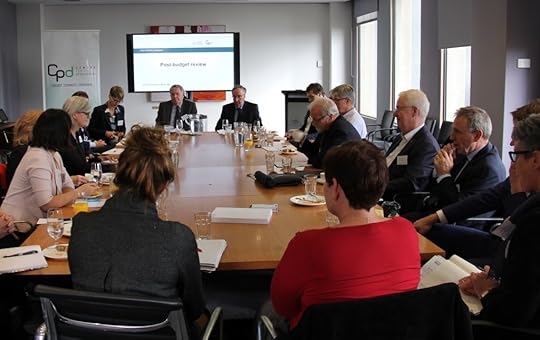
You can find an audio recording of the opening remarks of our speakers here [insert link].
On 10 May 2018, CPD and ANU invited leaders from government, business, civil society, academia and the media to reflect on the mid-term implications of the federal budget and to discuss how Australia’s fiscal priorities and processes stack up against the rest of the world.
Our Policy Dialogue was hosted by former Foreign Minister, the Hon Gareth Evans AC QC and moderated by Non-Executive Director and CPD’s Board Member Sam Mostyn. It featured:
Greg Smith (Chairperson at Commonwealth Grants Commission, member of the Henry Tax Review, and former CPD Treasurer)
Miranda Stewart (Professor, University of Melbourne Law School and former Director of ANU Tax and Transfer Policy Institute)
Peter Whiteford (Professor, Crawford School of Public Policy at ANU and CPD Fellow)
The key points at heart of our Dialogue were:
International economic drivers of budget forecasts;
Changes on the tax and revenue side, including anticipated changes to personal income tax rates;
Major changes in large social security programs and likely distributional impacts; and
Worrying global risks mentioned but glossed over in the budget papers.
The interactive discussion commenced with opening remarks by our three speakers. Greg Smith started off providing his observations of the strategy behind the federal budget and outlining the major economic drivers of budget forecast. Miranda Stewart gave a perspective on the tax to GDP ratio and budget rules, the income tax reforms, and their combined effect on future tax reform. Peter Whiteford, Australia’s foremost expert on social security and taxes-and-transfers policy, took a longer view on where this might head, not least the so-called “hard cap” on tax/GDP.
The opening remarks were followed by a wide-ranging discussion with a diverse and expert audience. Participants included: Conny Lenneberg (CEO, Brotherhood of St Laurence), Daniel Gradwell (Senior Economist, ANZ), Emma Dawson (CEO, Per Capita), Gareth Evans AC QC (Chancellor, ANU and former Foreign Minister), Greg Smith (Chairperson, Commonwealth Grants Commission), Janine Dixon (Economist, Centre for Policy Studies), Kelly O’Shanassy (CEO, Australian Conservation Foundation), Lynne Haultain (Executive Director, Victoria Law Foundation), Megan Flynn (Group Manager Environment and Carbon Strategy, Qantas), Mike Fitzpatrick (Former Chairperson AFL Commission), Miranda Stewart (Professor, University of Melbourne Law School), Misha Ketchell (Editor, The Conversation), Paul Orton (Global Head – Project & Export Finance, International & Institutional Banking, ANZ), Peter Binks (CEO, Business/Higher Education Round Table), Peter Whiteford (Professor, Crawford School of Public Policy at ANU), Rachel Ball (Head of Public Policy and Advocacy, Oxfam Australia), Sam Hurley (Policy Director, Centre for Policy Development), Sam Mostyn (Non-Executive Director and CPD board member), Shelley Mallett (General Manager, Research and Policy, Brotherhood of St Laurence), Terry Moran AC (Chair, CPD and former Head of the Department of Prime Minister and Cabinet), Travers McLeod (CEO, Centre for Policy Development).
Other key points of the discussion included:
How our budget is coping with the new economy, apart from the measures to tackle the black economy;
Outcomes that go beyond tax calculations (considering social, human and natural capital); and
Rethinking governance to respond to Australia’s biggest policy challenges.
CPD would like to thank Gareth Evans and the team at ANU House for hosting the event, and participants who contributed to an engaging and expert start to the ANU-CPD Policy Dialogue Series.
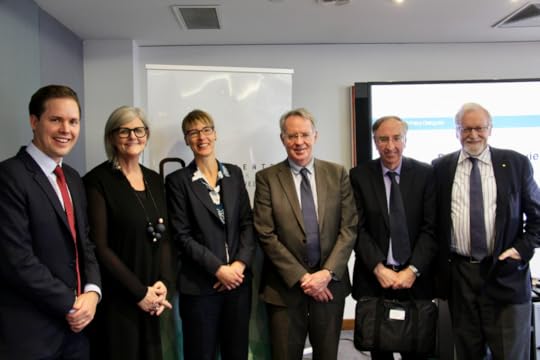
The post Post-budget review | ANU-CPD POLICY DIALOGUE | May 2018 appeared first on Centre for Policy Development.
May 7, 2018
Council on Economic Participation for Refugees
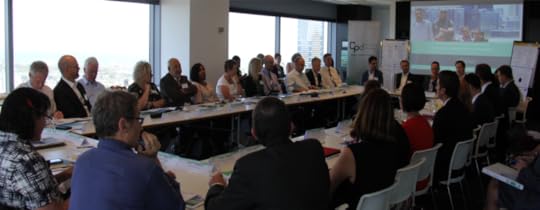
Key documents:
Full agenda
Participant list
First Council summary
On 22 February 2018, CPD convened the first meeting of the Council on Economic Participation for Refugees (the Council), hosted by the Boston Consulting Group in Melbourne.
The Council is the first pillar of CPD’s new Cities and Settlement Initiative (CSI).
The Council brings together key federal and state government officials with service providers, international experts and the metropolitan and regional cities that are settling the most refugees. We are focused on building integrated service delivery to improve the economic participation of refugees.
The objectives of the inaugural Council meeting were threefold:
Establish a common understanding of the barriers to refugee employment, through updated CPD-BCG analysis of refugee employment outcomes and of the current employment services landscape;
Initiate discussion about a range of more effective responses to overcome these barriers; and
Agree on the goals, activities and cadence of meetings for the Council.
Key issues discussed at the Council can be encapsulated within six inter-related themes:
Gender – women face a disproportionate number of barriers to economic participation although currently no government-led employment programs specifically focus on women’s needs.
Employment Services – existing employment services struggle to generate better outcomes for the most disadvantaged jobseekers, with jobactive failing to respond adequately to the needs of refugees.
Language – poor English-language proficiency is a significant barrier to employment, but employment and language programs are not integrated.
Skills Recognition – problems with recognition and the cost of certification of humanitarian migrant skills contribute to skilled refugees being un- or under-employed.
Local Knowledge and Coordination – local governments and local networks could be better leveraged to assist the settlement and employment journey of humanitarian refugees.
Engaging Employers – employers aren’t sufficiently engaged with services or with policy design/delivery to understand barriers and opportunities to refugee recruitment, including work experience.
Responses to reduce or overcome the barriers identified were discussed, narrowing in on three areas:
Employment services and the need to reform existing models – a personalised, whole-of-career and whole-of-family approach, changing the funding model, and building provider capability.
Enhancing the role of local government in coordinating settlement and employment services – local government can facilitate access to local employer and social networks using a place-based approach.
Improving provision of language services – English language training has been found to work best when it is practice-based, delivered within a workplace and/or built into other activities.
Participants were enthusiastic about continuing and further developing the Council, noting the unique assembly of perspectives and the great potential for driving policy and practice reform in this important area.
Working groups of Council members are forming around central themes to: develop a further understanding of issues; seek further information as necessary; and work through policy and practice responses in more detail.
CPD provides secretariat support to the Council, with the ongoing assistance of the Boston Consulting Group.
The post Council on Economic Participation for Refugees appeared first on Centre for Policy Development.
May 6, 2018
Cities and Settlement

CPD is proud to announce our Cities and Settlement Initiative, consisting of three pillars delivered over three years.
The Cities and Settlement Initiative (CSI) aims to improve the economic participation of refugees in Australia. Our analysis tells us this would deliver a triple dividend: benefiting vulnerable Australians; boosting the budget; and improving community cohesion.
We seek better governance and coordination connected to partnerships and delivery at the local level. Our objectives include:
streamlining arrangements between federal, state and local governments;
developing an integrated service delivery model that improves labour market participation;
identifying best practice to be replicated and scaled; and
knitting more tightly together selected regional and capital cities and providers undertaking refugee settlement.
CSI is supported by the Myer Foundation and the Vincent Fairfax Family Foundation and follows CPD’s February 2017 report, Settling Better: Reforming refugee employment and settlement services, released with the support of the Boston Consulting Group.
Settling Better showed that the social and economic prize on offer if Australia can settle refugees better is enormous. A modest improvement would produce $2.5 billion more income for refugees and their families over the next decade and almost $1 billion more for the government. The benefits are far more than financial. Better job outcomes have the potential to strengthen social cohesion and reduce alienation and extremism – not just amongst refugees, but also amongst established members of the Australian community who might fear or resent newcomers.
CSI aims to deliver Settling Better’s vision in the local government areas settling the most refugees. Many of these cities, like Fairfield in Western Sydney, or Greater Dandenong and Hume on the outskirts of Melbourne, must be exemplars at settlement and ensure successful participation of refugees into local communities and economies. Local governments like these experience first-hand the challenges associated with welcoming newly arrived refugees, but often do so in silos, excluded from critical policy design. CSI will seek to counter this by boosting policy memory, capability and coordination across local governments, and their connection to state and federal government.
CSI builds off a central idea: settling refugees successfully makes cities successful. Not just capital cities, but large regional centres too. Cities, which embed into their DNA the successful integration of their most vulnerable settlers, are vital for Australia to remain a welcoming, successful, and open nation.
The Cities and Settlement Initiative has three components:
1. A council on economic participation for refugees
The Council seeks to recharge governance on refugee employment and settlement. We bring together all levels of government, inject fresh insights from cities, settlement providers and civil society, and provide a clear purpose: economic integration. For more on the Council, see here.
2. A knowledge hub on best practice
The council on economic integration will require better evidence about what works. This means promising practices and policy measures to get refugees into appropriate jobs faster must be carefully evaluated and adjusted to ensure success. CSI’s second pillar does just that, building a knowledge hub for the settlement services sector, to identify and evaluate promising practices, share the evidence to service providers on digital platforms, and make the evidence available to governments via the council on economic integration.
3. An innovation network on civic engagement
Local initiatives, which lift civic engagement of refugees are often siloed, unknown, and struggle to attract money. CSI’s Innovation Network will meet in person and online to identify creative programs at grass-roots level, evaluate selected programs, then leverage resources in the start-up community and government to find a path for growth and replication of successful programs.
At the heart of CSI’s Innovation Network is the intent to boost community participation by refugees, and to help them to take full advantage of the opportunities on offer for safer and more secure futures.
We look forward to keeping you updated as we delivery this exciting initiative.
KEY DOCUMENTS
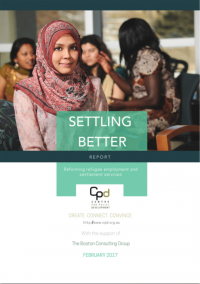
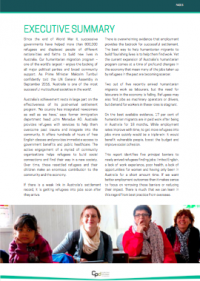
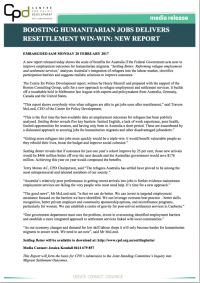
Full report
Executive summary and foreword
Media release
Media
Helping refugees build new lives: Q&A with Peter Shergold, The Mandarin, 15.03.2018
‘The catch-22’: refugees to Australia struggle to find work, The Guardian, Ben Doherty, 20.03.2018.
How to better help refugees and asylum seekers enter the workforce, ABC Radio, Amand Smith, 12.12.2017.
Boosting Refugee Jobs Would Be A Win-Win For Australia, The Huffington Post, Henry Sherrell and Travers McLeod, 24.02.2017.
Finding jobs faster for new refugees a ‘triple win’ for Australia, report finds, The Guardian, Ben Doherty, 21.02.2017.
We’ve lost the knack of finding jobs for refugees, The Australian, Terry Moran and Larry Kamener, 20.02.2017.
AMP, Harvey Norman, Woolworths and Telstra back refugee jobs plan, Australian Financial Review, Laura Tingle, 19.02.2017.
Refugee settlement government has ‘no centre of gravity’, The Mandarin, David Donaldson, 20.02.2017.
Related reading:
A Significant Contribution: The Economic, Social and Civic Contributions of First and Second Generation Humanitarian Entrants, Department of Immigration and Citizenship, 2011.
Building a New Life in Australia: The Longitudinal Study of Humanitarian Migrants, Department of Social Services, 2015.
The post Cities and Settlement appeared first on Centre for Policy Development.
April 19, 2018
Has Gonski stepped outside the square? I CHRIS BONNOR I Inside Story
The second Gonski report has been presented to the federal government, and will soon to be made public. Will it back innovative ideas to improve schools — and if it does, will it get the support it needs?
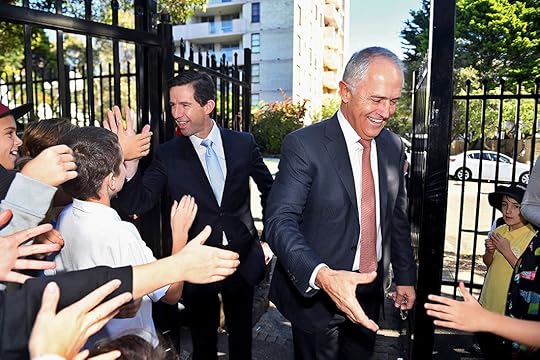
A bigger picture? Education minister Simon Birmingham with prime minister Malcolm Turnbull at Bondi Public School in Sydney last May. Brendan Esposito/AAP Image
The first thing I did when I became a secondary school principal many years ago was to put the school’s prefects in blazers and ties. The school was losing enrolments and needed to improve its profile; prefects were put in the vanguard of our efforts to win back a critical mass of aspirant families. The second thing was to invite Sydney University educationalist David Smith to speak to the staff. Even then, David was ahead of his time, delivering a telling critique of what he saw as outdated industrial-era schooling and a strong case for more personalised learning.
The first was a cosmetic change we needed to stay viable. Pursuing desirable students, and the benefits they bring, is common enough among schools in a competitive environment. The second was more challenging and risky; it meant reshaping the school and who it served, and could be far more significant if it worked.
What to do, and how far to go? To me, the most innovative schools seemed to fall into two categories: high-demand schools that could do no wrong, and low-demand schools that had nothing to lose. It was true up to a point, but I mistakenly consigned much of what they did to the fringes of schooling. What schools like mine did to lift engagement and retention was to tweak the system by introducing a more diverse curriculum, including vocational education. It was quite successful, as far as it went — but it didn’t go far enough.
After I retired I visited a number of innovative schools and always walked away not only with admiration for the energy of school leaders and teachers, but also with a greater awareness of the institutional, cultural and micro-political constraints on what they wanted to do. As a part-consequence, the innovations, just like mine, tended to be added to what was considered the main work of schools rather than changing how we do schooling itself. And the diversity I saw was as much about schools positioning themselves in the market as it was about catering for differences in student learning.
Two big things have changed over the years, and both have implications for where we go next. The first big change comes from our decision to allow, and even encourage, students with ability and advantages to gravitate to schools with similar students — not just in private schools but also in certain government schools. The flipside is that we have compounded disadvantage in other schools, and increased the challenge of improving their experience and performance. The late Bernie Shepherd and I have put numbers on this trend. It is incremental but alarming, and not much can improve if we don’t reverse it.
But it is the second change that is the focus of this article. There’s ample evidence of a serious disconnect exists between young people and their schools. The Mitchell Institute has detailed the extent of the problem at various stages of schooling, and the Grattan Institute concludes that as many as 40 per cent of school students are unproductive in a given year.
While it is rarely stated in these terms, the problem of disengagement lies behind many of our efforts to improve student outcomes, the latest big effort being the second Gonski review. When the review panel asked us what students need to learn at school, my first thought was to come up with an erudite list of capabilities, skills and knowledge. But if students aren’t engaged in learning then not much else will happen, and we will always fall well short of our most treasured goals.
This sent me back to what David Smith talked about decades ago. Maybe the real question is whether game-changing innovation can take hold if schools still look decades old. Lock-step student progression; siloed learning driven by externally created curriculum; exquisitely designed and imposed assessment hoops through which students must jump on command — it could well be that these features of schooling are blocking the innovation we need.
Has anyone managed to do it differently? Some schools tick all the boxes for the critics of the current system, producing students who are engaged, equipped and successful. “One student at a time in a community of learners,” as one group of schools puts it. Learning is designed around characteristics that are proven, in combination, to be essential for student engagement. These are the Big Picture schools that I first saw in operation in the United States, a country where I’ve seen the very best and the most ordinary of schools. Over the past decade, Big Picture schools, both government and non-government, have expanded in Australia, especially in New South Wales, Western Australia and Tasmania.
My lasting impressions of these schools include memories of the students who told me about what they were doing, in language of learning and purpose that I have rarely heard in a mainstream school. I won’t forget the Big Picture school in a poor area, without a fence, untarnished by graffiti and vandalism, an island of pride and hope in a neighbourhood of despair. And it was a great experience to be in these schools with teachers who were probably working harder but didn’t want to go back to what it was like before.
For students between years nine and twelve, Big Picture schools bring together a future focus, academic rigour, real-world learning, collaboration and participation. The approach is highly personalised and built on the student’s own passions. Relevance is maintained by links between schools and workplaces: students spend up to two days a week in an interest-based, curriculum-linked internship with a mentor from the community. It is a fundamental redesign of learning.
The significance of these schools is not that they will or should supplant mainstream schools. It’s the fact that their very existence urges a rethink of how we do schooling, and who benefits and who misses out. The questions framed by the current Gonski review were aimed at encouraging people to rethink what they were doing, contemplate what they wanted and state what gets in the way. Even the federal minister urged us to “think outside the square” — but more on that later.
Gonski asked us what students need to learn at school and how their achievement can be measured. Any educator can come up with a list of what should be learnt, though it will be hard to make real progress without authentic student engagement. The sting in the tail is the second part of the question: how do we measure achievement? If there is any aspect of pedagogy that is ripe for change it is the system of external assessment, which stifles student engagement and in-depth learning.
Gonski also asked what we can do to improve learning for all students. We’re starting from a position where schools manifestly don’t serve all students. They come to school with a diversity of personal resources, interests, abilities and learning styles; there is no guarantee — and in many cases not even the remotest possibility — that the schools available to them will maximise their potential to achieve their best. It is a substantial and unacknowledged equity problem, one that touches young people across the socio-educational spectrum and should be a major target of the review’s recommendations for innovation.
Gonski has asked us to be specific about what works and what gets in the way. This brings me back to the minister’s entreaty for those of us writing submissions to think outside the square. The idea of a square is a perfect metaphor to describe the boundaries within which schools operate. The boundaries, the four sides, are patrolled by people and forces that act to keep schools contained and conventional.
Forming one of these boundaries are the decisions of governments, schools and related authorities. These include the requirements imposed by curriculum and testing authorities; government decisions, both proactive and reactive, about priorities for school reform; and processes of accountability. The Gonski panel calls them enablers, but they don’t seem to enable, or at least encourage, deep innovation. Narrow measures of student worth and achievement can especially undermine the great things schools do, and distort the purpose of schooling itself.
Forming a second boundary are the public’s views about what constitutes a desirable and successful school. They include inherently conservative, recycled and often dated ideas about schools — and are reflected in much media reporting of how schools should be judged.
The third boundary is created by a market culture that drives competition and choice, and seems to inhibit risk-taking innovation. Bringing market forces into education has meant that schools are more similar than most people imagine: only the brave stray beyond the expected look and feel. It’s time we called out school competition for what it is: a failed policy that has created and further divided winners and losers.
But not all the problems are external. The fourth boundary is the culture within which some schools and school systems operate. School leaders work hard to introduce improvements but are often handicapped by pockets of conservatism and inertia in the teaching profession — and certainly not helped by ill-advised initiatives from governments and school authorities. It takes a special school leader to overcome external constraints and the lack of trust in the system among teachers.
We have reformed schools for decades, pitched them into competition and tested them to the hilt — while slicing and dicing the student population to suit the preferences of some. Improving the capacity of all schools to reach and inspire all students must be seen as the priority. We need not only to rethink what goes on inside classrooms but also be prepared to redesign how learning takes place across the school. Engaging all students is a serious equity challenge, equal to the ongoing need for resource equity highlighted by the first Gonski review six years ago.
We have the opportunity to learn from schools that succeed outside the square and to make them part of the mainstream. We need those who put the boundaries around schools to serve rather than constrain or distort the agreed priorities of schooling. And if we are going to measure anything inside schools then we should start, and maybe finish, with the indicators of students’ engagement, belief in learning and belief in their futures. If we improve these then the other things we want will stand a much better chance.
Everyone even remotely involved in school innovation has a stake in what happens after Gonski reports. Our students have the highest stake of all. School leaders and their peak groups especially need to remember what happened after the first Gonski review, how an opportunity to create a far more even playing field for all students was substantially lost. We can’t afford to make the same mistake twice. ●
The post Has Gonski stepped outside the square? I CHRIS BONNOR I Inside Story appeared first on Centre for Policy Development.
April 12, 2018
Decentralisation and Democratic Renewal | ANU-CPD POLICY DIALOGUE | March 2018
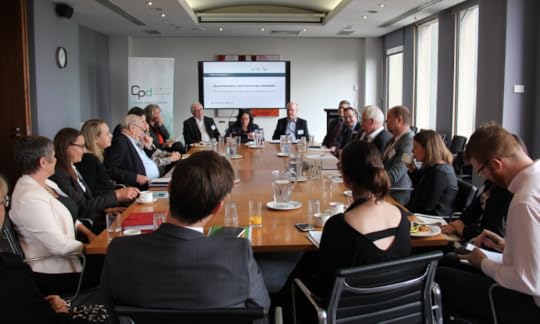
On 29 March 2018, CPD and ANU invited leaders from government, business, civil society, academia and the media to discuss the question ‘can decentralisation boost our regions and improve Australia’s democracy?’. The roundtable considered the extent to which decentralisation can spur growth, better government, and improved human services across Australia. It was a timely discussion given the Federal Government’s recent decentralisation push and new CPD research on Australia’s democracy, undertaken in partnership with Essential and ANU’s Professor Glenn Withers AO. A key discovery of that research was community support for more decentralisation: 75 per cent of Australians are in favour of embedding the public sector in major cities and regions.
Our Policy Dialogue was hosted by former Foreign Minister, the Hon Gareth Evans AC QC and moderated by CPD’s Chair Terry Moran AC. It featured Professor Glenn Withers AO (ANU), Mark Birrell (former Chair of Infrastructure Australia), Nadine Flood (National Secretary, Community and Public Sector Union), and Simon Pryor (Executive Director Policy, Business Council of Australia).
Key points of the discussion
The key questions at heart of our Dialogue were:
Can decentralisation spur growth, better government, and improved human services across Australia?
What are opportunities for growing business activity linked to regional economic strengths?
What might an (independent) framework for decentralisation look like?
The interactive discussion commenced with some opening remarks by our speakers. One of the speakers noted that decentralisation is always associated with the most egregious examples and that the topic needs to be discussed properly since the evidence is showing that putting most things in one place doesn’t always work. It was also said that one key consideration should be how decentralisation can be used to spur growth in places where there wouldn’t otherwise be growth (including our cities). We also heard about the history of the idea and how it is usually dismissed as a key policy/design vector but receives strong support among the public and that it has larger payoffs than we might think. This was supported by some practical governance and design examples.
The opening remarks were followed by a wide-ranging discussion with a diverse and expert audience. Participants included: Anthea Harris (Lead Deputy Secretary, Strategy and Planning at Department of Economic Development, Jobs, Transport and Resources, Victoria), Bo Li (Senior Policy Officer, Victorian Local Governance Association), Bronwen Clark (Executive Officer, National Growth Areas Alliance), Collin Ross (Mayor of Cardinia Shire Council), David Donaldson (Journalist, The Mandarin), Danielle Storey (CEO, Eastern Innovation Business Centre), Gareth Evans AC, QC (Chancellor, ANU), Gemma Henderson (Principal, The Boston Consulting Group), Gillian Sparkes (Victorian Commissioner for Environmental Sustainability), Glenn Withers (Professor of Economics, ANU), Holly Ransom (CEO, Emergent), Jim Miller (Chair, Infrastructure Victoria), Kathryn Arndt (Chief Executive Officer, Victorian Local Governance Association), Mark Birrell (Former Chair of Infrastructure Australia), Michael Rowland (Co-presenter ABC News Breakfast), Michelle Cox (Policy Adviser, Business Council of Australia), Nadine Flood (National Secretary, Community and Public Sector Union), Sarah Barker (Special Counsel, MinterEllison), Simon Pryor (Executive Director Policy, Business Council of Australia), Stuart Whitman (Research Engagement Manager, Australian Catholic University), Terry Moran AC (Chair, Centre for Policy Development), Travers McLeod (CEO, Centre for Policy Development).
Other key points of the discussion included:
Decentralisation through increasing size of the APS instead of their relocation.
Decentralisation of government bodies to cities and towns where local workforces encompass the skill base of the new agency.
The link between decentralisation and the improvement of human services such as settlement services to help refugees find work faster which would be a triple-win for Australia.
CPD would like to thank Gareth Evans and the team at ANU House for hosting the event, and participants who contributed to an engaging and expert start to the ANU-CPD Policy Dialogue Series.
Related Documents
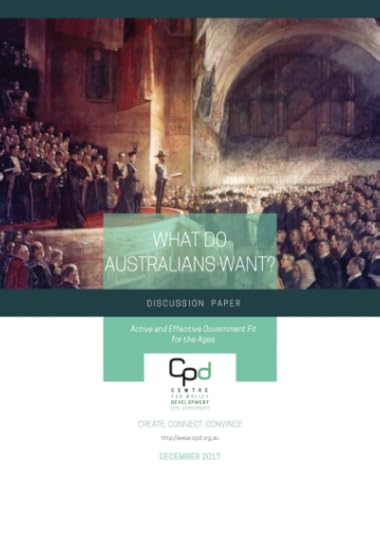
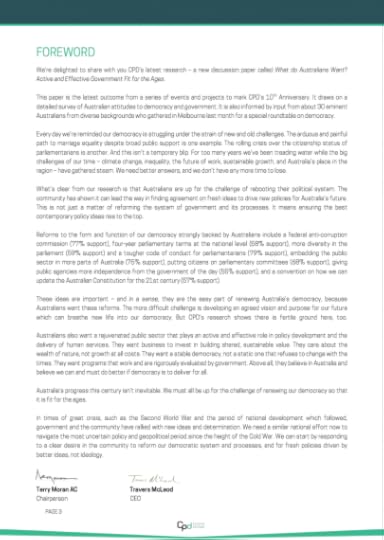
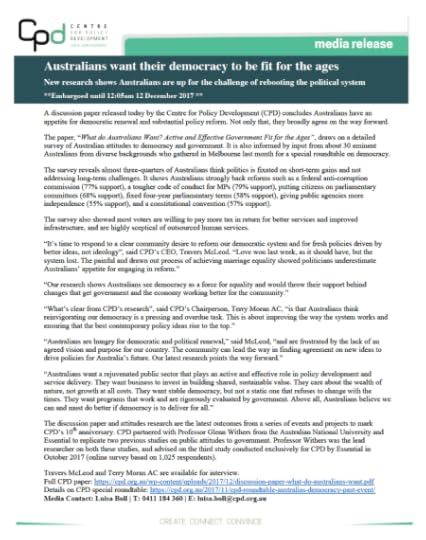
Full discussion paper
Foreword
Media release
The post Decentralisation and Democratic Renewal | ANU-CPD POLICY DIALOGUE | March 2018 appeared first on Centre for Policy Development.
COME WORK FOR US!
The post COME WORK FOR US! appeared first on Centre for Policy Development.
March 19, 2018
How to better help refugees and asylum seekers enter the workforce on Life Matters
Published on ABC’s RN Tuesday 12 December 2017 9:06AM (view full episode)
Download audio
Imagine moving to a new country and having to learn from scratch the systems of society. But the culture is so different and you’re expected to sell yourself in a way that would have seemed rude and very inappropriate back in your country of birth.
This is the reality for many new to this country: while modern Australia has been shaped by waves of immigration, newly-arrived migrants, refugees and asylum seekers still have trouble finding work, no matter how much they want to.
Ahmad Raza, a recruitment and field officer with the Brotherhood of St Laurence, discusses Given the Chance, a program that gives one-on-one support to refugees and asylum seekers.
John Van Kooy, a PhD candidate and a migration and social inclusion researcher with Monash University, also tells Life Matters about some of the best ways to support newly-arrived migrants to find jobs.
Producer
Erica Vowles
The post How to better help refugees and asylum seekers enter the workforce on Life Matters appeared first on Centre for Policy Development.
March 15, 2018
Sixth meeting | ASIA DIALOGUE ON FORCED MIGRATION | March 2018
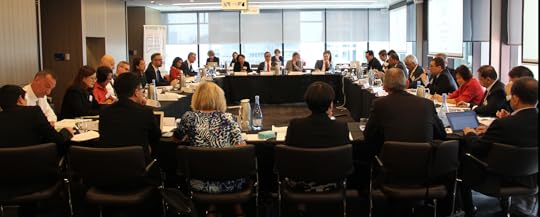
Key documents for the sixth ADFM meeting:
Full agenda and participant list
Briefing papers
Participant profiles
Press Release
The sixth meeting of the Asia Dialogue on Forced Migration (ADFM) took place on 13-15 March 2018 in Sydney, Australia, ahead of the ASEAN-Australia Special Summit and at a critical time for forced migration issues in the region. The meeting focused on the humanitarian crisis in Bangladesh and Myanmar; efforts to address human trafficking, forced labour and modern slavery; and principles for sustainable and protection-sensitive repatriation and reintegration pathways.
Much has happened since the ADFM’s last meeting in Manila in September 2017. Since then, in line with the ADFM’s advice, Bali Process Co-Chairs triggered the emergency Consultation Mechanism in response to the humanitarian and security crisis in Myanmar and Bangladesh. The ADFM’s recommendations on a focal point system to aid ACTIP’s implementation and collaboration between ASEAN and the Bali Process senior officials were endorsed by the ASEAN Ministers’ Meeting on Transnational Crime (AMMTC) and are being implemented by the ASEAN Senior Officials Meeting on Transnational Crime (SOMTC). Co-Chairs of Bali Process Working Groups on TIP and Disruption of Criminal Networks, respectively, are pursuing greater coordination with the SOMTC.
ADFM members have also advised on the two global compacts on migrants and refugees, which are now in their zero draft state. The global compact on migration includes recognition of the importance of regional governance and architectural arrangements that promote coordination on forced migration issues, in keeping with the example that the ADFM has set in the Asia-Pacific region.
Australia has announced its intention to introduce a Modern Slavery Act into Parliament in 2018, which, if passed, will change the landscape for businesses in the region as well as other governments. It is likely to add further momentum to the growing business awareness and interest in addressing trafficking, forced labour and slavery in operations and supply chains. We were delighted to have the Hon Alex Hawke MP, Assistant Minister for Home Affairs, and the Hon Lisa Singh, Senator for Tasmania, take part in a moderated discussion about the legislation at our special ADFM dinner on 14 March.
The ADFM Secretariat expresses its appreciated to Corrs Chambers Westgarth for hosting the sixth meeting in Sydney. Consultations will continue between ADFM members in coming months to advance the recommendations agreed at this meeting. The seventh ADFM meeting will likely take place in Bangkok in late 2018, in the lead up to Thailand becoming ASEAN Chair in 2019.

Background reading:
For the ADFM home page click here.
To find out more about the rationale behind the ADFM click here.
To read more about the first ADFM meeting in Melbourne in August 2015 click here.
To read more about the second ADFM meeting in Bangkok in January 2016 click here.
To read more about the third ADFM meeting in Kuala Lumpur in September 2016 click here.
To read more about the fourth ADFM meeting in Jakarta in March 2017 click here.
To read more about the fifth ADFM meeting in Manila in September 2017 click here.
The post Sixth meeting | ASIA DIALOGUE ON FORCED MIGRATION | March 2018 appeared first on Centre for Policy Development.
March 5, 2018
CPD climate work featured in 4Corners ‘Weather Alert’ report
Last night the ABC’s 4Corners program aired a special report about how Australian farmers, businesses and regulators are responding to climate change.
CPD’s Sustainable Economy Program has been making the case for business leaders and regulators to seize the initiative on responding to climate change, rather than be paralysed by the inaction of policymakers.
‘Weather Alert‘ showcased some of the highlights of CPD’s research and advocacy, and how this work is contributing to a major shift in corporate and regulatory leadership on climate change. These included:
The Noel Hutley SC opinion on company directors’ legal obligations to consider how climate change is impacting their businesses. CPD commissioned this opinion with the Future Business Council in 2016.
A major speech given by APRA’s Geoff Summerhayes at CPD’s ‘ Building a sustainable economy forum in November 2017. Geoff’s speech highlighted the risks and opportunities climate change creates for Australia’s banks, insurance firms and superannuation funds, and provided another powerful signal that APRA and other regulators are now paying more attention to the financial impacts of climate change.
Recent statements by RBA Governor Philip Lowe endorsing new global standards for the disclosure of climate risk and confirming the Council of Financial Regulators has established a new working group to focus on these issues. Both of these steps were key recommendations of CPD’s 2017 Climate horizons report by Sam Hurley and Kate Mackenzie.
‘Business as usual no longer an option’. For a full rundown of @CentrePolicyDev‘s work on climate risk, directors’ duties & scenario analysis visit https://t.co/fElznSoXyN #4Corners
— Travers McLeod (@TraversMcLeod) March 5, 2018
CPD Policy Director Sam Hurley, who was interviewed by 4Corners for the report, said that recent public statements by APRA and the Reserve Bank represented some overdue long-term leadership on the growing impacts of climate change:
“I think it sends a very powerful message.
The RBA and APRA – they’re big, serious institutions. They don’t take these steps lightly. They’re not talking about climate on a whim.
They’ve studied the evidence, they’ve looked at what their counterparts are doing internationally, and they’ve looked at the trends and risks in Australia, and they’ve decided that now’s the time to raise the bar.
It would have been very hard to see 12 months ago when there was a lump of coal doing the rounds of parliament, that Australia’s key financial regulators would provide such decisive leadership on climate risk over the next 12 months.
But they have, starting with APRA and now the RBA and that’s potentially very significant.”
You can see the full report or read a transcript here: http://www.abc.net.au/4corners/weather-alert/9511070
Associated media coverage
While politicians question the reality of climate change, farmers and businesses act Michael Brissenden, ABC News Online, 5 March
The Australian farmers adapting to climate change ABC Radio AM, 5 March
Related reading
Legal opinion and roundtable on directors duties and climate risk – CPD, October 2016
The evolving role of company directors – CPD board member Sam Mostyn’s address to ACID 2018 Governance Summit, March 2018
Grey clouds and silver linings – climate change a financial reality for Australian business – Sarah Barker, Minter Ellison, December 2017
The post CPD climate work featured in 4Corners ‘Weather Alert’ report appeared first on Centre for Policy Development.
Centre for Policy Development's Blog
- Centre for Policy Development's profile
- 1 follower



